The English Bulldog, a breed renowned for its distinctive appearance and lengthy history, showcases a captivating spectrum of coat colors and patterns. From the rarest to the most common, these variations express a multitude of charm and uniqueness. This article will explore the standard coat colors and patterns of English Bulldogs that are recognized by kennel clubs. It will also lightly touch on non-standard colors. Each coat color and pattern enhances the breed’s aesthetic appeal and historic attraction as one of the most iconic breeds we know today.

The English
Bulldog
originated from England, likely around the 13th century.
©Tatiana Katsai/Shutterstock.com
Standard vs. Non-Standard English Bulldog Colors and Patterns
English Bulldog, or Bulldog, colors and patterns, as for any breed of dog, can vary between what is considered standard and non-standard colors and patterns. And it’s crucial to distinguish between the two. Standard colors and patterns are recognized and regulated by official breed standards and kennel clubs such as the American Kennel Club (AKC). Let’s quickly explore what sets them apart before we dive into English Bulldog colors.
Standard Coat Colors and Patterns
Standard coat colors and patterns represent the traditional and officially recognized variations for a particular breed. They are well-documented in breed standards and have a historical or genetic basis. These standard variations are considered the ideal representation of the breed. In the context of English Bulldogs or any other breed, adhering to standard colors and patterns as a reputable breeder is essential for preserving the breed’s heritage and ensuring conformity to established norms.
Non-Standard Coat Colors and Patterns
Conversely, non-standard coat colors and patterns deviate from the officially recognized variations outlined in breed standards. These variations may result from selective breeding for novelty or aesthetics rather than adherence to breed heritage and genetics. Non-standard colors and patterns can introduce genetic complexities and may not align with the breed’s historical origins.
While non-standard variations can be visually appealing, it’s important to note that responsible breeders prioritize the health and well-being of dogs. Breeding for non-standard colors is acceptable, but it should not be done at the risk of compromising a dog’s overall health or temperament.
The distinction between standard and non-standard coat colors and patterns is a fundamental aspect of responsible breeding and breed preservation. Breed standards serve as a guideline to maintain the integrity and heritage of dog breeds. For this list, we will explore the standard colors and patterns expressed in the English Bulldog breed, as recognized by the American Kennel Club.

The English Bulldog is an iconic breed that exhibits a variety of coat colors and patterns. Some are recognized by kennel clubs are standard colors, while others are not.
©Lakshmi3/iStock / Getty Images Plus via Getty Images
10 Standard English Bulldog Colors
English Bulldogs exhibit a diverse array of coat colors, each with its level of rarity or commonality within the breed.
Fallow English Bulldogs
Fallow is one of the rarest English Bulldog coat colors. It is characterized by a pale, yellowish-brown hue. Bulldogs with this color variation are somewhat uncommon, making them a unique occurrence that brings delight to breeders.
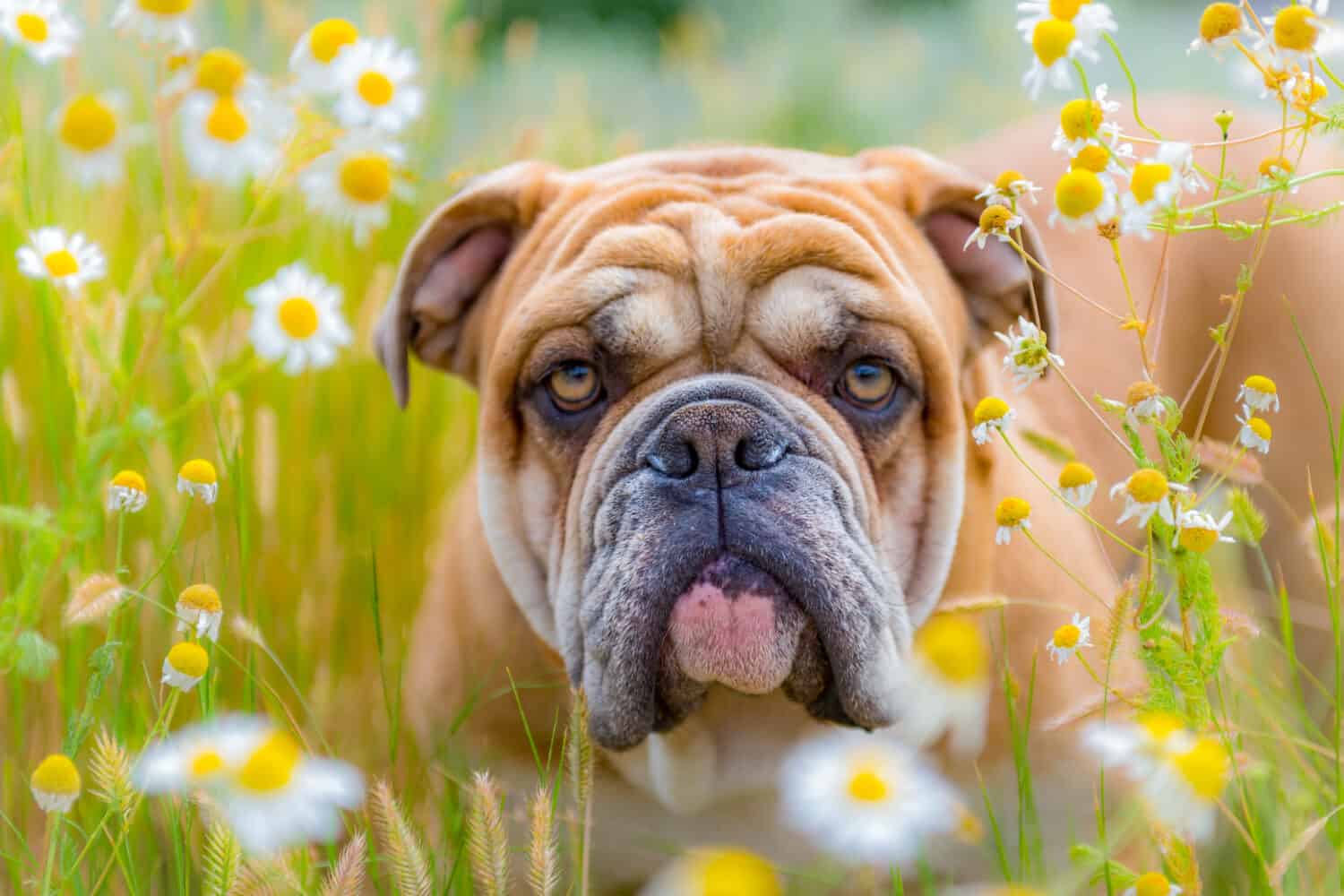
Fallow is one of the rarest standard colors within the English Bulldog breed.
©BGSmith/Shutterstock.com
Fawn and Brindle English Bulldogs
Fawn and brindle Bulldogs combine two standard colors, which are fawn and brindle. This pattern features a fawn base with darker brindle stripes, resulting in a striking appearance. While not as rare as fallow, this combination is still relatively uncommon.
Fawn Brindle and White English Bulldogs
Fawn brindle and white Bulldogs display a blend of fawn, brindle, and white patches. This pattern, while distinctive, falls into the category of less common coat variations among English Bulldogs. White is typically the base color, with fawn and bridle coexisting as secondary colors.
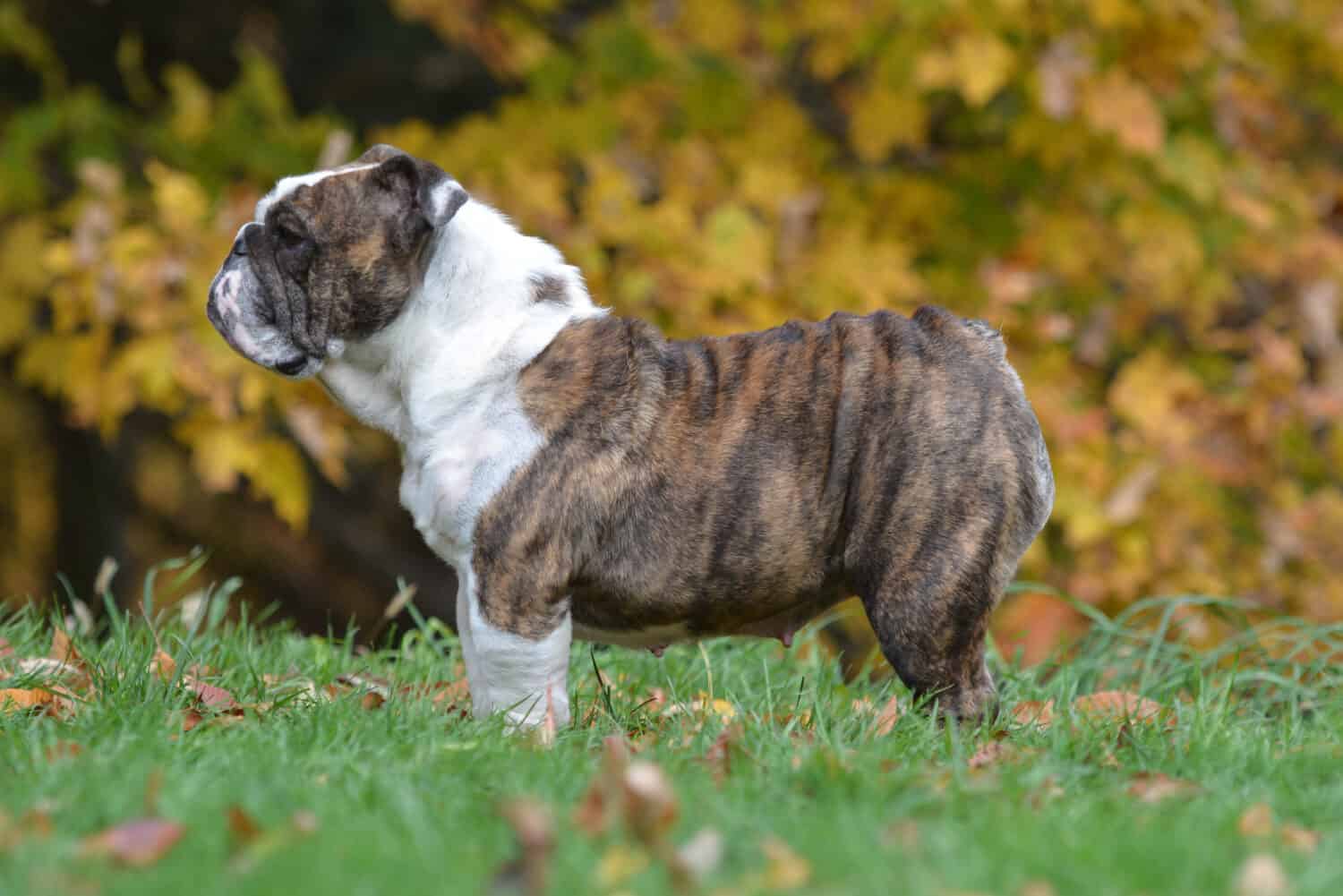
Fawn brindle and white are rare, but it isn’t incredibly common when compared to other standard colors of this breed.
©WilleeCole Photography/Shutterstock.com
Red Brindle English Bulldogs
Red brindle Bulldogs feature a base color of red with dark brindle stripes. This combination is visually appealing and ranks moderately in terms of rarity within the breed.
Red Brindle and White English Bulldogs
Similar to red brindle, red brindle, and white Bulldogs incorporate white patches or a base into the mix. While not as common as some other variations, this color pattern can still be found often enough among the breed.

Red bridle and white a striking coat color recognized by kennel clubs as a standard color.
©WilleeCole Photography/Shutterstock.com
Fawn English Bulldogs
Fawn Bulldogs have a solid tan or yellowish coat with a black mask around their faces. Although not exceedingly rare, this color is relatively common when considering traditional coat colors such as red and white.
Red English Bulldogs
Solid red Bulldogs possess a deep, uniform red coat. They are more common than some of the previously mentioned variations but still retain their distinctive appearance.

Red is a common color in English Bulldogs.
©Irene Miller/Shutterstock.com
Fawn and White English Bulldogs
Fawn and white Bulldogs exhibit a combination of fawn and white colors. While not the most common, this pattern is seen more frequently than the rarer coat variations.
Red and White English Bulldogs
Red and white Bulldogs feature a mix of red and white colors. This combination is quite common within the breed but is still considered distinctive.
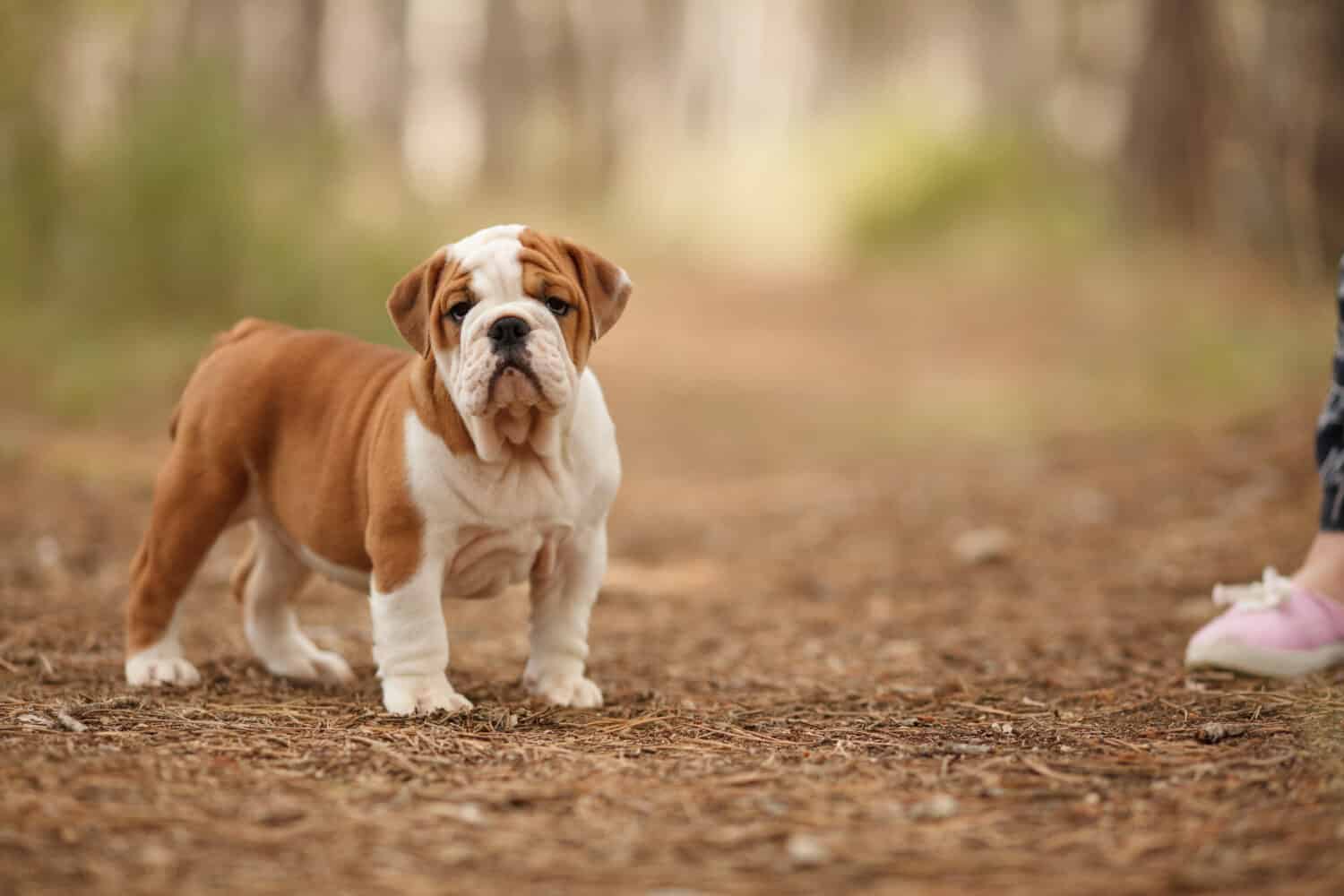
Red and white English Bulldogs are some of the most common.
©Serova_Ekaterina/Shutterstock.com
White English Bulldogs
White Bulldogs are also pretty common among the recognized English Bulldog coat colors. These dogs have predominantly white coats with minimal or no color markings. While white Bulldogs are prevalent, they still represent the breed’s unique charm and are often viewed as a classic coat color.
Overall, English Bulldogs boast a diverse range of coat colors, with fallow being one of the rarest and white or red and white being some of the most common according to American Kennel Club standards. Furthermore, each color variation contributes to the breed’s individuality and visual characteristics.
6 Standard English Bulldog Patterns
As for coat patterns, English Bulldogs showcase a variety of coat patterns that contribute to their unique and appealing appearances. These standard patterns, recognized by the American Kennel Club, range in rarity and distinctiveness.
Ticked Pattern on English Bulldogs
Ticked Bulldogs possess small, fleck-like spots scattered across their white coat. This pattern is relatively rare among English Bulldogs, making ticked individuals stand out.
Black Tips on English Bulldogs
Black tips refer to Bulldogs with black-tipped hairs on their coat. While not exceedingly common, this pattern is more frequently encountered than ticked coats.
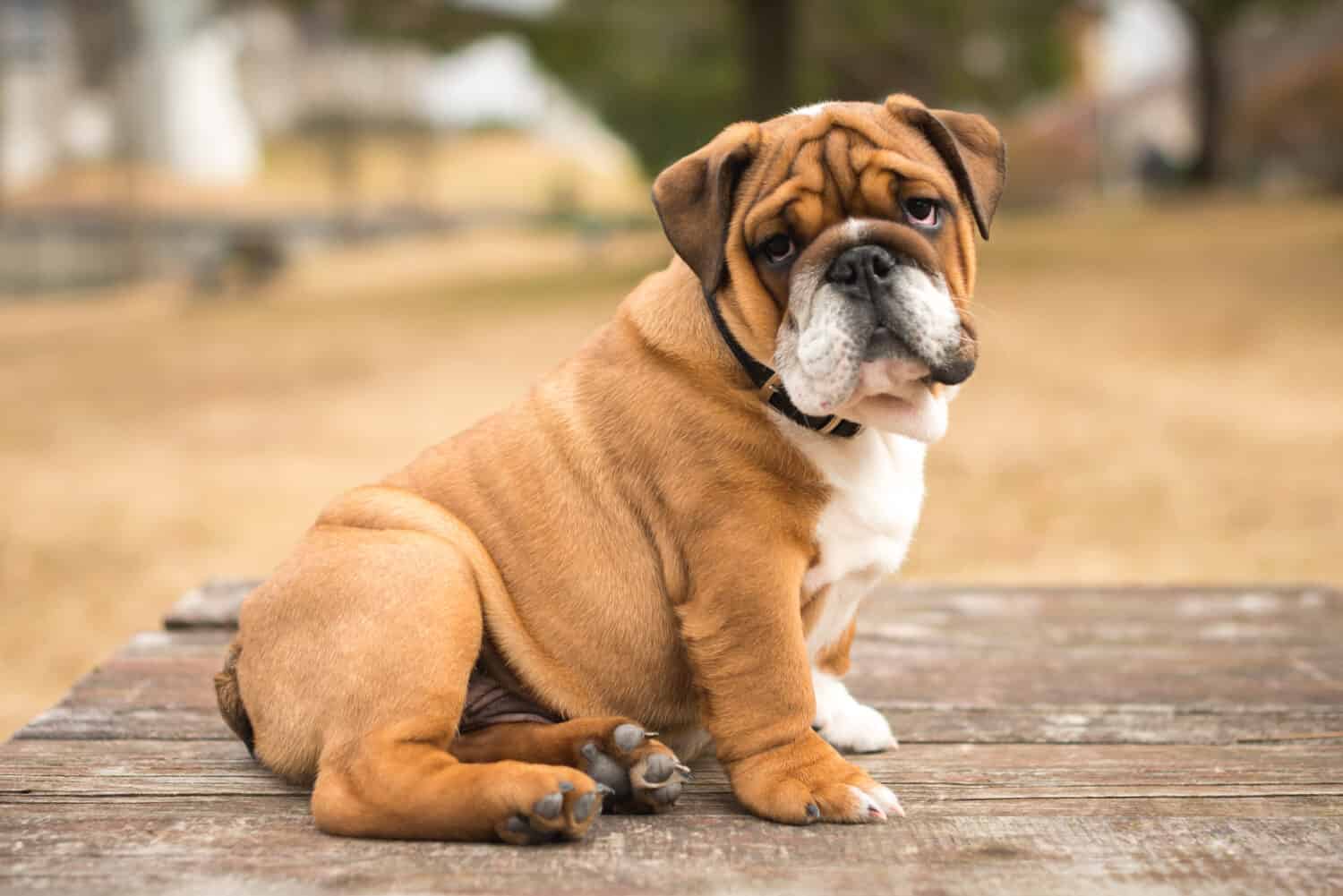
Black tips are a rarer color pattern that English Bulldogs can exhibit in their coats. As they sound, they include hairs with black tips.
©Kassio KM/Shutterstock.com
Piebald Pattern on English Bulldogs
Piebald Bulldogs have a predominantly white coat with well-defined yet randomized patches of any standard color. This striking pattern is relatively uncommon but is a recognized and distinctive variation.
Black Mask on English Bulldogs
A black mask pattern involves a solid black coloring or patch on the face, often covering the muzzle. It’s a moderately common pattern among English Bulldogs and adds a touch of elegance to their appearance.
White Markings on English Bulldogs
White markings refer to Bulldogs with patches or spots of white on their coat, typically against a background of a standard color. This pattern is more common than the previously mentioned ones but still retains its distinctiveness.

Some of the most common colors English Bulldogs exhibit are red, white, or a combination of both.
©Ann Tyurina/Shutterstock.com
Brindle Pattern on English Bulldogs
Brindle is the most common coat pattern among English Bulldogs. This pattern is so common amongst certain colors that it is included in various standard coat colors. It consists of dark stripes (often black) on a lighter background color, such as fawn. This classic and well-recognized pattern is a hallmark of the breed.
Overall, English Bulldogs exhibit a range of coat patterns, with ticked being one of the rarest and brindle being one of the most common, by American Kennel Club standards.

English Bulldogs have six standard coat patterns, including ticked, black tips, black mask, piebald, brindle, and white markings.
©Lunja/Shutterstock.com
Rarest to Most Common English Bulldog Colors
| Rank | Color |
|---|---|
| 1 | Fallow |
| 2 | Fawn and Brindle |
| 3 | Fawn Brindle and White |
| 4 | Red Brindle |
| 5 | Red Brindle and White |
| 6 | Fawn |
| 7 | Red |
| 8 | Fawn and White |
| 9 | Red and White |
| 10 | White |
Rarest to Most Common English Bulldog Patterns
| Rank | Pattern |
|---|---|
| 1 | Ticked |
| 2 | Black Tips |
| 3 | Piebald |
| 4 | Black Mask |
| 5 | White Markings |
| 6 | Brindle |

English Bulldogs have ten standard coat colors.
©ltummy/Shutterstock.com
English Bulldog History
The English Bulldog, also simply called Bulldog, is a beloved breed known for its distinctive stout and sturdy appearance, charming coat colors, and unique history. Its history exemplifies the breed’s resilience and adaptation.
Origins
We can trace the English Bulldog’s roots back to approximately 13th-century England. It is believed to have descended from mastiff-type dogs. People bred them for the original purpose of bull-baiting, which was, at the time, a popular sport.
Evolution of the Breed and Bull-Baiting
One of the most significant and initial chapters in the Bulldog’s history was its role in bull-baiting. In medieval, bull-baiting was a popular and brutal sport. People selectively bred Bulldogs to be courageous, strong, and impervious to pain as they faced the immense aggression of provoked bulls. This selective breeding shaped the breed’s physical characteristics, including its muscular build, powerful jaws, and the iconic brachycephalic or pushed-in face.
The coat color and pattern of Bulldogs during this era were not a primary focus. This aspect came into play later in their history. The breed’s primary function at this time was to excel in bull-baiting. Thus, coat variations were not a priority. However, it’s important to note that Bulldogs of this time likely exhibited a range of colors, including brindle and fawn.
From Bull-Baiting to Dog Shows
The 19th century brought about significant changes in England, including a shift away from blood sports like bull-baiting. The Cruelty to Animals Act of 1835 effectively banned such activities. This shift in societal values led to a transformation in the Bulldog’s purpose and appearance.
While bull-baiting was prohibited, illegal pit-dog pit fighting gained popularity. The breed was bred with terrier types at this time to produce a quicker, more feisty dog. This resulted in many bull-type breeds we know today, such as the Bull Terrier and Staffordshire Bull Terrier.
Simultaneously, breed enthusiasts began to focus on preserving the breed, transforming their purpose from fighting dog to a family companion. The Bulldog’s temperament and physical appearance were refined, emphasizing a gentle and amiable disposition. At the same time, efforts were made to standardize the breed’s physical characteristics, including coat color and pattern. By 1873, the English Bulldog was officially recognized as a breed by The Kennel Club, while in 1886, it was recognized by the American Kennel Club. This recognition marked a pivotal moment in the breed’s history, as it solidified the Bulldog’s status as a distinct and respected breed within the dog world.
Coat Color and Pattern in the Breed Standard
As the breed’s function evolved, so did the importance of coat color and pattern within the breed standard. Breed enthusiasts began to recognize specific color variations and their appeal. This recognition led to the inclusion of standard coat colors and patterns in the official breed standards, with the American Kennel Club taking a prominent role in this process. All of which was important to protect the integrity of the breed.
Today, the AKC recognizes ten standard coat colors and six standard coat patterns for English Bulldogs, including fawn, brindle, red, and white, among others. These standards ensure that Bulldogs adhere to certain visual norms, adding to the breed’s overall integrity and attractiveness in the show ring.
Evolution of Coat Color Preferences
Over the years, preferences for certain coat colors and patterns have evolved within the Bulldog community and outside of the show ring. While brindle and fawn were historically typical, today’s enthusiasts also appreciate the unique beauty of merle and black, as well as other colors and variations. The emphasis has shifted from the strict adherence to breed standards of coat color to more interest in aesthetics for those not interested in showing.
Modern Challenges
While the Bulldog has come a long way from its bull-baiting origins, it still faces health and genetic diversity challenges. The breed’s distinctive appearance, including its pushed-in face, can lead to respiratory issues. Responsible breeders are increasingly focusing on breeding for health and longevity rather than extreme or unique physical characteristics. This shift is essential for the breed’s long-term well-being.
The English Bulldog’s history is long and filled with intention. The breed has weathered changing times from its roots in bull-baiting to its transformation into a cherished companion and show dog. Coat color and pattern have played a role in this journey, with standards evolving to reflect the breed’s modern yet historic image.
Today, the Bulldog is an iconic breed that has had many breeds descendant from it. It symbolizes the enduring spirit of a breed that has overcome challenges and evolved to become a beloved member of countless families worldwide.
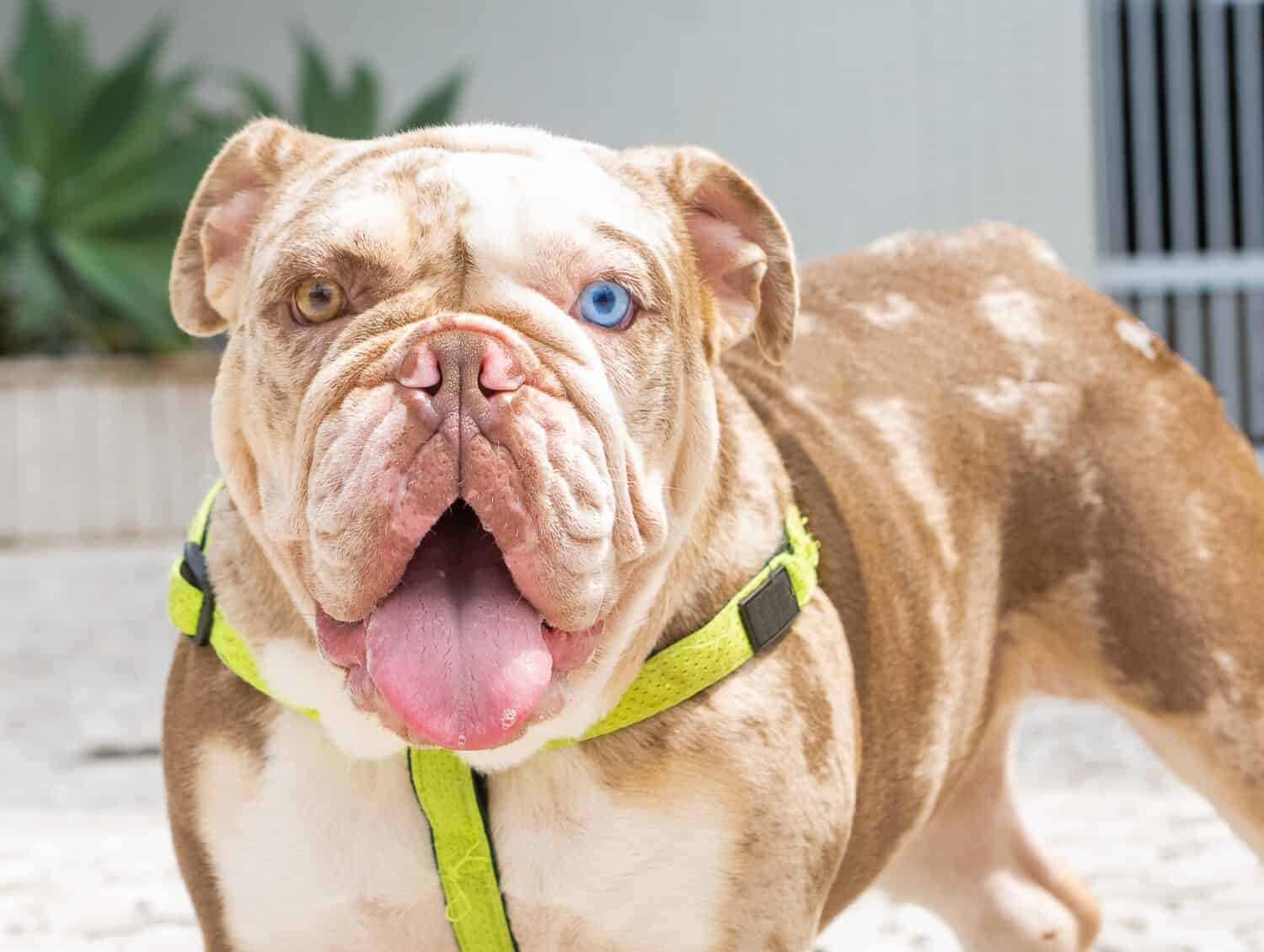
Merle is a non-standard coat color that can be found in the English Bulldog breed.
©Will Rodrigues/Shutterstock.com
Conclusion
In the world of English Bulldogs, coat colors and patterns are not just superficial traits. They are also a reflection of the breed’s history and evolution. From the rarest to the most common, the coat colors and patterns of English Bulldogs express diverse beauty.
At the rarer end of the spectrum lies fallow, a pale, yellowish-brown hue that is exceptionally scarce in the breed. Ticked coats featuring tiny, scattered spots also stand out as uncommon. Black tips follow, characterized by black-tipped hairs, while piebald Bulldogs sport predominantly white coats with well-defined yet randomized patches of color, creating a striking appearance.
Moving towards the more common end, we find the iconic black mask, a solid patch of black on the face that adds an elegant touch. White markings introduce patches or spots of white with a standard color. Finally, the most common coat pattern is brindle, featuring dark stripes on a different color background, epitomizing the classic Bulldog look. Red or white, or the combo of both, are quite common colors in the breed.
These coat variations not only enhance the breed’s aesthetic appeal in their ways. The English Bulldog’s coat colors and patterns have also further evolved from the standard coat colors and patterns, introducing rare colors such as merle or black. All of which reflect the breed’s visual adaptability and enduring charm. Whether rare or common, each variation contributes to the breed’s unique identity, making the English Bulldog a beloved and recognizable breed around the world.
The photo featured at the top of this post is © Tatiana Katsai/Shutterstock.com
Ready to discover the top 10 cutest dog breeds in the entire world?
How about the fastest dogs, the largest dogs and those that are -- quite frankly -- just the kindest dogs on the planet? Each day, AZ Animals sends out lists just like this to our thousands of email subscribers. And the best part? It's FREE. Join today by entering your email below.
Thank you for reading! Have some feedback for us? Contact the AZ Animals editorial team.






